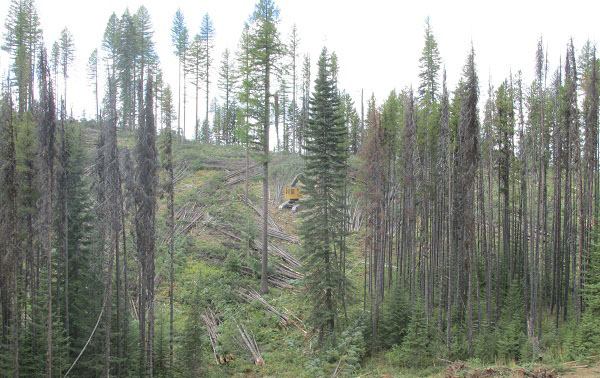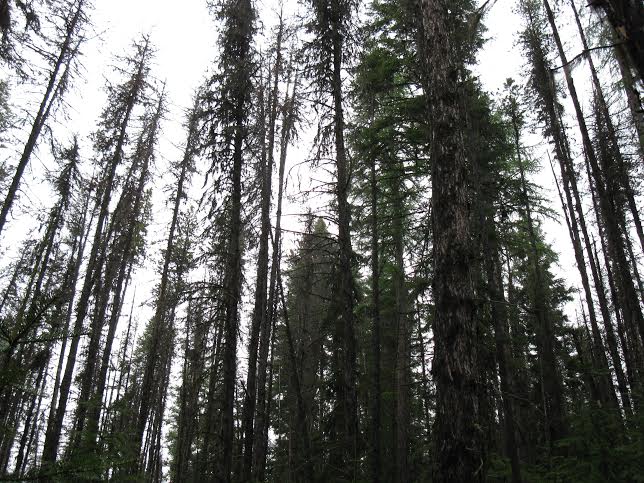Andy Kerr wrote this op-ed for the Medford, Oregon Mail-Tribune. Full text is below. Lots to discuss, but I have just a couple of points:
>> “Wildfire is not a threat to east-side Oregon ponderosa pine-dominated forests. Wildfire is either the continuation or rebirth of forests.”
Even the intense, stand-replacing fires that burn in areas where, as Andy writes, “fire exclusion has resulted in east-side dry forest stands that have too many small trees and not enough large trees.”? And if fire is not a threat, should we not attempt to suppress them?
>> “I don’t know of any credible conservation organization that says never another federal log.”
This is still Sierra Club policy, as far as I know — downloaded it today here:
“The Sierra Club support[s] protecting all federal publicly owned lands in the United States and advocate[s] an end to all commercial logging on these lands.” Adopted in the Sierra Club Annual Election, April 20, 1996.
GUEST OPINION
Guest Opinion: East is east and west is west
By Andy Kerr
Posted Jan. 6, 2015 @ 12:01 am
Since the Mail Tribune’s editorial “Meeting in the middle keeps a mill open” (Jan. 2) mentioned my role in the general ceasefire between conservationists and the timber industry over Oregon east-side federal public forest lands, permit me to compare some differences with its west-side counterpart.
I challenge the editorial’s notion that “the key to breaking the impasse was a recognition on the part of environmentalists that wildfire posed as much of a threat to forests as logging. Wildfire is not a threat to east-side Oregon ponderosa pine-dominated forests. Wildfire is either the continuation or rebirth of forests. Wildfire is good; non-firesafe buildings are bad.
The triple-threat of livestock grazing, high-grade logging and fire exclusion has resulted in east-side dry forest stands that have too many small trees and not enough large trees.
A plethora of smaller young trees are out-competing the dearth of larger old trees for moisture, nutrients and light, which stresses old-growth trees, making them more vulnerable to native insects and diseases and dying centuries before they naturally would.
In the case of dry forests, judicious thinning of younger trees can restore ecological health.
Fundamental to achieving cooperation among the east-side interests was that, since 1995, Forest Service policy generally prohibits the logging of trees over 21 inches in diameter at breast height. In addition, since 2001, large roadless areas are generally off-limits to logging. There are no comparable protections on Bureau of Land Management (the so-called “O&C”) lands in Western Oregon. The approximately eight eastside Oregon mills have reinvented themselves to utilize smaller trees.
Another difference is federal revenue sharing. Traditionally, counties received a percentage of timber receipts. For national forests, it was 25 percent; for O&C lands it was 75 percent. The Forest Service has moved toward stewardship contracts, where timber revenues are retained by the agency and used for non-commercial forest and watershed restoration activities and developing more ecological restoration projects.
In contrast, BLM still envisions a return to the bad old days when the O&C counties were rolling in federal timber receipts. Such was only possible when over two square miles per week of Oregon old-growth forests were being clearcut.
Milling capacity on the east side is more closely aligned with ecological restoration needs. Since 1995 — the year the protections for the west side’s northern spotted owl and the east side’s big trees went into full effect — the number of wood products mills and jobs in Oregon have halved. Yet today, milling capacity (the appetite for logs) is one-quarter larger than it was in 1995. Far fewer mills and mill jobs, but the remaining mills are much larger and more efficient.
There are eight mills — centered in Douglas and Lane counties — that require very large logs from very large and old trees. Seven of these dinosaur mills actually modernized their equipment to more efficiently use large logs — like modern whaling stations that use every bit of the whale. Their business model requires large logs, now found only on federal lands and for which the social license to log has expired and won’t be renewed. The nearly 40 other west-side Oregon sawmills have moved beyond old growth.
More significant than forest type or geography are the differences between the Forest Service and BLM. The Forest Service now generally views logs as a byproduct of scientifically sound ecological restoration. BLM still generally views logs as the paramount purpose of O&C lands. The Western Oregon federal public forestlands managed by BLM are national forests; they just aren’t capitalized National Forests managed by the Forest Service.
Sen. Ron Wyden advanced O&C legislation in the Senate that would have protected more forests and also increased log supplies. There is a lot in his bill I did not like, but I supported it.
In contrast, Reps. Greg Walden and Peter DeFazio passed a bill through the House of Representatives that would effectively privatized 1.5 million acres of O&C lands to be logged like adjacent private timberlands.
Wyden’s bill died because Senate leaders didn’t have time to deal with a bill that they knew Walden would kill in the House.
The editorial concluded with “No one wants to go back to the unsustainable clearcutting that devastated forests in the 1970s and 1980s. But saying no to all timber harvests everywhere isn’t realistic either.”
I don’t know of any credible conservation organization that says never another federal log. I do know of O&C counties and west-side mills that still want to clearcut old-growth forests and refuse to scale their demands to those which are ecologically, economically and socially acceptable.
Andy Kerr (www.andykerr.net) advocates for the conservation of the public’s lands, wildlife and waters and splits his time between Ashland and Washington, D.C.

